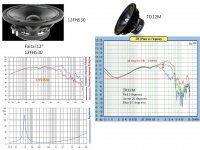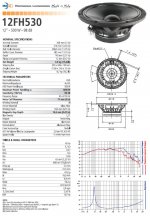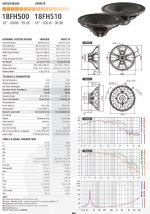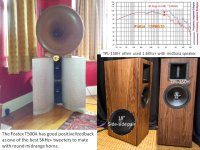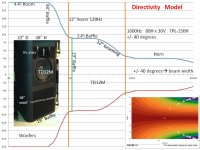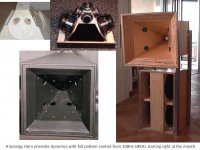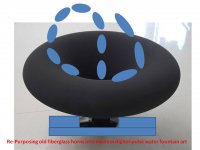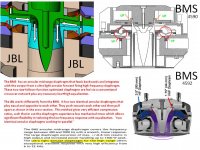I am at a turning point in my speaker building journey. Having recently heard the Grimm LS1's i am re-evaluating the need for mid range horns which i currently use. I have the Beyma TPL's which i like alot and am considering a sealed mid range driver to replace the midrange and midbass horns, allowing me to drop one way out my rig.
I have seem the beyma 12P80Nd in a sealed configuration, recommended to go with the TPL. I have access to a pair of beyma 122Nd's which to my untrained eye seem very similar just a slightly lighter cone, higher fs ( not the same power rating - but don't need 700w domestically).
From some simple calcs messing with Qes i seem to be able to get a similar response for both drivers with a f3 of around 90hz. in a sealed cabinet for a Q of 0.7. It all seems to good to be true, or am i compromising the performance for the price of a pair of drivers? (Is the 122Nd - not in same league as the 12P80Nd sonically?)
From recent posts it looks like what i am aiming to build has been done already in the tweek geek BMF1, excepting i am changing all the drivers except the TPL. (peerless XLS 12" for the bass)
I have looked at the faital 12FH530 driver that was used in the BMF1, but am not sure if going to marry with TPL as well.
I have seem the beyma 12P80Nd in a sealed configuration, recommended to go with the TPL. I have access to a pair of beyma 122Nd's which to my untrained eye seem very similar just a slightly lighter cone, higher fs ( not the same power rating - but don't need 700w domestically).
From some simple calcs messing with Qes i seem to be able to get a similar response for both drivers with a f3 of around 90hz. in a sealed cabinet for a Q of 0.7. It all seems to good to be true, or am i compromising the performance for the price of a pair of drivers? (Is the 122Nd - not in same league as the 12P80Nd sonically?)
From recent posts it looks like what i am aiming to build has been done already in the tweek geek BMF1, excepting i am changing all the drivers except the TPL. (peerless XLS 12" for the bass)
I have looked at the faital 12FH530 driver that was used in the BMF1, but am not sure if going to marry with TPL as well.
The Beyma 122ND has an Xmax of just 2mm. The Beyma 12P80Nd has an Xmax of 7.5mm. Very different motors.
THE USUAL SUSPECTS:
1--My favorite is the Lambda TD12M because it has the lowest harmonic distortion and matched polar at 1600Hz(and I own a pair)
2--From the datasheet, the Faital 12FH530 also looks excellent. Low Le shorting ring on the pole. Dampeded cone breakup. Good SPL polar match to TPL horn.
3--From the datasheet, the Beyma 12P80Nd has the highest BL=23.1 and BL/Mms(56g). The cone uses composite paper plus carbon fiber. The mirrored(2-spider) suspension is linear to 7.5mm xmax. The datasheet SPL shows cone breakup ~2Khz which suggests a steep slope active Xover is beneficial. The Qtc=0.17 offers motor controlled speed with accuracy which several say is necessary to match the TPL-150.
4--From the datasheet, the 18Sound 12NMB420 also looks excellent. Low Le, just 34g Mms, dampened cone breakup. Good SPL polar match.
FOR WOOFERS:
==== Sd ====
18" 1220 cm2
15" 855 cm2
12" 530 cm2
10" 345 cm2
8" 225 cm2
The large cone area of an 18" woofer provides high efficiency bass with modest distortion generating displacement. Side-to-Side physically connected woofer pairs use counter-forces to dramatically reduce vibrations. Two 18" woofers can provide high quality room-equalized bass from a sealed box alignment with modest watts. Two 18" woofers like (Faital 18FH500, Peavey LoRider18, Beyma 18LX60 rev1) which have modest Mms (140-180g) and Qts~ 0.37 connected in parallel in a sealed 9cuft volume can provide Qtc=0.7 alignment with F3=60Hz before equalization extends the bass to the 20-30Hz range... 30Hz at 100db SPL with 20 watts of power. I have sims if you are interested.
THE ITALIAN CONNECTION: Faital 12FH530 and two Faital 18FH500
probably the best overall driver pairing
THE USUAL SUSPECTS:
1--My favorite is the Lambda TD12M because it has the lowest harmonic distortion and matched polar at 1600Hz(and I own a pair)
2--From the datasheet, the Faital 12FH530 also looks excellent. Low Le shorting ring on the pole. Dampeded cone breakup. Good SPL polar match to TPL horn.
3--From the datasheet, the Beyma 12P80Nd has the highest BL=23.1 and BL/Mms(56g). The cone uses composite paper plus carbon fiber. The mirrored(2-spider) suspension is linear to 7.5mm xmax. The datasheet SPL shows cone breakup ~2Khz which suggests a steep slope active Xover is beneficial. The Qtc=0.17 offers motor controlled speed with accuracy which several say is necessary to match the TPL-150.
4--From the datasheet, the 18Sound 12NMB420 also looks excellent. Low Le, just 34g Mms, dampened cone breakup. Good SPL polar match.
FOR WOOFERS:
==== Sd ====
18" 1220 cm2
15" 855 cm2
12" 530 cm2
10" 345 cm2
8" 225 cm2
The large cone area of an 18" woofer provides high efficiency bass with modest distortion generating displacement. Side-to-Side physically connected woofer pairs use counter-forces to dramatically reduce vibrations. Two 18" woofers can provide high quality room-equalized bass from a sealed box alignment with modest watts. Two 18" woofers like (Faital 18FH500, Peavey LoRider18, Beyma 18LX60 rev1) which have modest Mms (140-180g) and Qts~ 0.37 connected in parallel in a sealed 9cuft volume can provide Qtc=0.7 alignment with F3=60Hz before equalization extends the bass to the 20-30Hz range... 30Hz at 100db SPL with 20 watts of power. I have sims if you are interested.
THE ITALIAN CONNECTION: Faital 12FH530 and two Faital 18FH500
probably the best overall driver pairing
Attachments
THE ITALIAN CONNECTION: Faital 12FH530 and two Faital 18FH500
probably the best overall driver pairing
And the new 18 XL1800 ??
(Is the 122Nd - not in same league as the 12P80Nd sonically?)
I ran a simple sim on the 122Nd which estimated that with 2mm Xmax at 90Hz it can generate ~ 101db @1m maximum SPL before the distortion would increase from out-of-gap over extension. Xdamage is 16mm, so increased distortion would probably be the main concern for high SPL transients.
The 122Nd SPL/freq curve in the datasheet shows ~5db increase jump at the primary cone diameter resonance(400-500Hz) which you would want to check with your own measurements before constructing a crossover.
========Subwoofers====
From the datasheet, the NEW Faital Pro 18XL1800 looks like a great high power, high output woofer capable of scary SPL deep bass. MMs = 245g, Le=2.04mH, Qts=0.40.
Simulate two 18XL1800 in a sealed 9cuft box with a 20Hz Linkwitz transform and see how much power is required for 100db SPL @30Hz.
I favor 18" woofers with modest Mms(like 170g), modest Le(like 0.9mH) and smaller box Qtc(like 0.37 ) which in a 9cuft box plus 20Hz LinkWitz transform can generate 100db @30Hz with 20 watts of power(without room gain added). A philosophy of power efficient bass over monster high SPL bass.
Thanks for the detailed responses.
Understanding what you are saying about the midrange, the 122nd is possible but there are compromises, unlikely to go above 100db in my 5m x 4m listening room, the response isn't as flat as the other options, but thats correctable with my DSP. ( maybe should have said i intend to run active).
Your mentioning the TD12M's reminded me i have some Altec 414'z in the cupboard gathering dust, they are low qts, so may sim them in IB.
This idea of replacing my midrange horn (200Hz Le cleach with JBL 2482 crossed @ 350hz) is not one of not likeing the horn, but i feel the integration below it is a weakness, that i have unsucessfully not solved, following 3 years of experimenting ( currently running a horn loaded super cardiod with 2 x 15" drivers per channel). Integrating IB is easier and taking the x-over below 100hz makes that even less challenging. So this midrange IB going upto 1300Hz has a lot to live upto.
I have considered the MT-E500M AMT, which can go as low as 300 Hz, but from PK's experience would need at least 2 per side to get the impact/dynamics. But again its crossing in a critical frequency band - so i may not sucessfully solve my integration problem.
Another option i have pondered are the BMR's - for midrange duty only.
On the subwoofer duty - are you suggesting 2 x 18" drivers per channel - it certainly will have impact, a 9 cuft cabinet just for subs is to big for my room. I would have thought the peerless 12" xls drivers with their extended travel would displace enough air. I appreciate the 18" would move less so lower distortion, but it the art of compromise.
Understanding what you are saying about the midrange, the 122nd is possible but there are compromises, unlikely to go above 100db in my 5m x 4m listening room, the response isn't as flat as the other options, but thats correctable with my DSP. ( maybe should have said i intend to run active).
Your mentioning the TD12M's reminded me i have some Altec 414'z in the cupboard gathering dust, they are low qts, so may sim them in IB.
This idea of replacing my midrange horn (200Hz Le cleach with JBL 2482 crossed @ 350hz) is not one of not likeing the horn, but i feel the integration below it is a weakness, that i have unsucessfully not solved, following 3 years of experimenting ( currently running a horn loaded super cardiod with 2 x 15" drivers per channel). Integrating IB is easier and taking the x-over below 100hz makes that even less challenging. So this midrange IB going upto 1300Hz has a lot to live upto.
I have considered the MT-E500M AMT, which can go as low as 300 Hz, but from PK's experience would need at least 2 per side to get the impact/dynamics. But again its crossing in a critical frequency band - so i may not sucessfully solve my integration problem.
Another option i have pondered are the BMR's - for midrange duty only.
On the subwoofer duty - are you suggesting 2 x 18" drivers per channel - it certainly will have impact, a 9 cuft cabinet just for subs is to big for my room. I would have thought the peerless 12" xls drivers with their extended travel would displace enough air. I appreciate the 18" would move less so lower distortion, but it the art of compromise.
a 9 cuft cabinet just for subs is to big for my room.
You have a 38" wide 200Hz LeCleach midrange horn.... how can you whine about a 9cuft woofer cabinet? Just built around the horn and go UP. Paint the cabinet the same color as your wall, or put a pretty picture on it... speaker camoufloge
Your DSP can provide room equalization and time alignment for the dual 18" woofers, and also time alignment for any horn tweeter choice above the JBL 2482 in the big LeCleach.
My midrange horn - isn't that big - its a 200hz horn crossed at 350hz - 68cm diameter. The attached image shows what space i have to play with, with respect to my current speakers. The wave guides on the TPL's are signficantly larger that the production ones and allow the crossing to be lowered to around 1200hz. Also they are firing into a 2 ltr box which is fully stuffed, which has lowered the distortion.
Doing the sums, for the proposal of 2 18" drivers in a 9 cuft box will need a 6" deeper and 4" wider box to get the internal volume. My current arrangement with 2 15" drivers move enough air, it just doesn't go low enough (40hz with equalisation). Maybe i will look to see if there are any suitable 15" sub driver (last time i looked they were either midbass or heavy coned subs)
I have seen a clone of the Daniel Hertz M1 mentioned in the past using a single 18", i assume the cabinet would need some structural considerations as there isn't the second driver to cancel the vibration effects.
Doing the sums, for the proposal of 2 18" drivers in a 9 cuft box will need a 6" deeper and 4" wider box to get the internal volume. My current arrangement with 2 15" drivers move enough air, it just doesn't go low enough (40hz with equalisation). Maybe i will look to see if there are any suitable 15" sub driver (last time i looked they were either midbass or heavy coned subs)
I have seen a clone of the Daniel Hertz M1 mentioned in the past using a single 18", i assume the cabinet would need some structural considerations as there isn't the second driver to cancel the vibration effects.
SWEET LeCleach! Wish I had one 
Have you experimented with using a small horn tweeter like the Fostex T90A or T500A? They were designed for integration with a round midrange horn. There are several positive feedback reports. You can locate the Fostex just under your LeCleach front edge and use your DSP for time alignment.
The Beyma TPL-150H has a 80H x 30V horn pattern. They are often mated to sealed boxed midrange speakers which gradually beam to +/- 40degrees around 1600Hz. This creates a smooth directivity function that provides a natural soundstage in many homes. Geddes has a good whitepaper. http://www.gedlee.com/downloads/directivity.pdf
I suspect you have enough spare stuff in storage to build a speaker like the BMF-1 around your TPL-150H. If you constructed a separate sealed woofer box you could also test it with your current LeCleach system.
Have you experimented with using a small horn tweeter like the Fostex T90A or T500A? They were designed for integration with a round midrange horn. There are several positive feedback reports. You can locate the Fostex just under your LeCleach front edge and use your DSP for time alignment.
The Beyma TPL-150H has a 80H x 30V horn pattern. They are often mated to sealed boxed midrange speakers which gradually beam to +/- 40degrees around 1600Hz. This creates a smooth directivity function that provides a natural soundstage in many homes. Geddes has a good whitepaper. http://www.gedlee.com/downloads/directivity.pdf
I suspect you have enough spare stuff in storage to build a speaker like the BMF-1 around your TPL-150H. If you constructed a separate sealed woofer box you could also test it with your current LeCleach system.
Attachments
I think the point of me wanting to replace the midrange is being missed. I have thougth that the TPL and a round horn don't work that well some time ago. What I do know is that integrating anything below the midrange horn is more challenging. I have some BMS 4592's. I used in the horns no integration issues at the top, my 10 ft listening position wasn't far enough back for them though to be on axis. So that's why I think the horn needs to be replaced, to ease integration, but what I replace it with needs 99% of the qualities of a big CD in a big horn, is this an impossible ask?
A Synergy Horn provides dynamics with full pattern control from 100Hz-18Khz starting right at the mouth. It solves the "big horns in a small room" delayed arrivals integration problems. Your DSP will greatly simplify the complex crossover. You could construct 60H x 60V horn, or 50H x 50V horn to remove the small room short latency wall/floor reflections that confuse the real stereo image.
My understanding of some good small room speaker options:
1) Remove small room effects: Synergy Horn with dipole woofers OR two sealed counter-force woofers if DEEP BASS is important.
3) Geddes controlled directivity: BMF-1 design. Control short delay room reflections down to 400Hz. My last post illustrated the polar pattern of sealed woofers + 12" midbass + TPL-150H.
3) I love wood horns: BMS 4592 in LeCleach with DSP boost on bass and treble. Adjust horn height and toe-in. Experiment with Geddes-type open cell foam to reduce tweeter beaming.
That wood LeCleach horn sure is a _B_E_A_U_T_Y_ Please don't turn it into a flower planter
My understanding of some good small room speaker options:
1) Remove small room effects: Synergy Horn with dipole woofers OR two sealed counter-force woofers if DEEP BASS is important.
3) Geddes controlled directivity: BMF-1 design. Control short delay room reflections down to 400Hz. My last post illustrated the polar pattern of sealed woofers + 12" midbass + TPL-150H.
3) I love wood horns: BMS 4592 in LeCleach with DSP boost on bass and treble. Adjust horn height and toe-in. Experiment with Geddes-type open cell foam to reduce tweeter beaming.
That wood LeCleach horn sure is a _B_E_A_U_T_Y_ Please don't turn it into a flower planter
Attachments
Last edited:
Hi Vinylnvalves,
If it was me, I would not consider using the BMS 4592ND in case you expect an improvement. I have tried these drivers in several horns and while they had SPL and dynamics in spades, I never succeeded making them sound natural. Too much sibilance (t- and s- sounds, especially on female vocals). I know that Bert Doppenberg uses the BMS 4592 in his Orphean speakers, which should sound good, but his drivers are modified mechanically somehow....
I also happen to have the Beyma TPL-150H and they sound much more natural and relaxed in their frequency range than at least I will ever be able to make the BMS coax'es do...
Best regards
Peter
If it was me, I would not consider using the BMS 4592ND in case you expect an improvement. I have tried these drivers in several horns and while they had SPL and dynamics in spades, I never succeeded making them sound natural. Too much sibilance (t- and s- sounds, especially on female vocals). I know that Bert Doppenberg uses the BMS 4592 in his Orphean speakers, which should sound good, but his drivers are modified mechanically somehow....
I also happen to have the Beyma TPL-150H and they sound much more natural and relaxed in their frequency range than at least I will ever be able to make the BMS coax'es do...
Best regards
Peter
those horns of mine are fibreglass.
Fiberglass....
Well.... ...OK Then...
Let's turn it into a modern water fountain, where digital pulses of water SHOOT up from the throat and SPLASH round the mouth and finally FLOW BACK down.
You don't love the treble.
You don't love the midbass.
What's not to love about a pulsed-water fountain?
An email to Bert Doppenberg discussing the BMS 4592 might let you put your water into just tea.
Attachments
Last edited:
Thank you !
Peter,
Thanks for sharing this. You have no idea how much this helps me, and undoubtedly should help others. Matter of fact, it is nice to hear from you and why don't you share some more of your experiences in the development of your system ?
best regards,
Scott L
Hi Vinylnvalves,
If it was me, I would not consider using the BMS 4592ND in case you expect an improvement. I have tried these drivers in several horns and while they had SPL and dynamics in spades, I never succeeded making them sound natural. Too much sibilance (t- and s- sounds, especially on female vocals). I know that Bert Doppenberg uses the BMS 4592 in his Orphean speakers, which should sound good, but his drivers are modified mechanically somehow....
I also happen to have the Beyma TPL-150H and they sound much more natural and relaxed in their frequency range than at least I will ever be able to make the BMS coax'es do...
Best regards
Peter
Peter,
Thanks for sharing this. You have no idea how much this helps me, and undoubtedly should help others. Matter of fact, it is nice to hear from you and why don't you share some more of your experiences in the development of your system ?
best regards,
Scott L
Ha ha
I do like the treble and I do like the midrange, its the integration to the midbass and below which is my current systems weakness.
The idea suggested of a couple of sealed drivers, covering up to 350hz is appealing. 18" drivers won't go that high, maybe a 15".
Before anyone mentions tapped horns for the bottom end, I have a surplus "coffin" from a previous experiment.
I do like the treble and I do like the midrange, its the integration to the midbass and below which is my current systems weakness.
The idea suggested of a couple of sealed drivers, covering up to 350hz is appealing. 18" drivers won't go that high, maybe a 15".
Before anyone mentions tapped horns for the bottom end, I have a surplus "coffin" from a previous experiment.
"The Truth is out there" ------- Speaker building is like The X-Files ---- I need to find the truth ---
Are you "satisfied" with your 28" diameter LeCleach horn using the DSP equalized BMS 4592 coaxial compression driver from 350Hz up to 18Khz when it is mounted near ear level NEXT TO your 2x woofer bass horn? (You might put the LeCleach on top of the woofers and just turn-off the top 15" woofer for an ear-height test. )
In post #9 I estimated that the center of your LeCleach was about 62" high and suggested removing the TPL-150 to test if bass integration improved as the you lowered the LeCleach closer to ear level. A small Fostex T90A could be mounted without raising the LeCleach with JBL 2482.
With DSP equalization on the BMS 4592, putting Geddes-type open cell foam just inside the LeCleach throat will slightly increase the tweeter air pulse power that mixes with the more powerful midange pulses inside the BMS 4592. The foam should remove more tweeter harmonics than midrange, and this might reduce the reported S'sssss sibilence. ----any thoughts?
(What model 15" woofers are you using? Have you modeled the bass horn up to 350Hz?)
Are you "satisfied" with your 28" diameter LeCleach horn using the DSP equalized BMS 4592 coaxial compression driver from 350Hz up to 18Khz when it is mounted near ear level NEXT TO your 2x woofer bass horn? (You might put the LeCleach on top of the woofers and just turn-off the top 15" woofer for an ear-height test. )
In post #9 I estimated that the center of your LeCleach was about 62" high and suggested removing the TPL-150 to test if bass integration improved as the you lowered the LeCleach closer to ear level. A small Fostex T90A could be mounted without raising the LeCleach with JBL 2482.
With DSP equalization on the BMS 4592, putting Geddes-type open cell foam just inside the LeCleach throat will slightly increase the tweeter air pulse power that mixes with the more powerful midange pulses inside the BMS 4592. The foam should remove more tweeter harmonics than midrange, and this might reduce the reported S'sssss sibilence. ----any thoughts?
(What model 15" woofers are you using? Have you modeled the bass horn up to 350Hz?)
Attachments
I tried the foam trick a couple if years back, I sourced some 6" dia. filter foams and wedged them in the throat. I did not really notice any improvement. Wrong location? Not sure if I am being convinced to go back to them yet. Noticed you compared the BMS 4590 and the BMS 4592 structures, I have both drivers, and when " upgrading" to the 4592 did not notice any improvement. Maybe with the DSP I should give them another go? I think I want to play first with other approaches. I have the offer of some 200hz AMT's to trial, which I may try. I believe if you can avoid Doppler discord, by keeping cone movement to a minimum then a direct radiator should be as good.
- Status
- This old topic is closed. If you want to reopen this topic, contact a moderator using the "Report Post" button.
- Home
- Loudspeakers
- Multi-Way
- Advise on mid range driver
